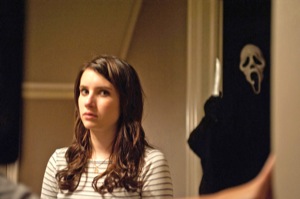
I’ve never liked horror movies or slasher films. As a genre, they’re usually exploitative; they go for the basest emotions, the simplest reactions, using buckets of blood to gross you out, gratuitous sex to get a rise out of you and the lamest of surprises to get you to jump out of your seat.

The villains are usually cartoonish boogey men in masks, actually scary only to children or people who haven’t discovered that the true terror is in the collapsing world economy, the security of former Soviet nuclear arms or the popularity of torture porn like Saw. These movies are all id, and it’s rare to find in them any art, emotion or lasting resonance.
For every brilliantly terrifying movie like Psycho, 28 Days Later, or The Descent, there are five movies like Hostel, Texas Chainsaw Massacre, I Know What You Did Last Summer, Final Destination, and the never- ending string of their sequels.
That’s why the original Scream, now 15 years old, was such a breath of fresh air, or, rather, a whiff of fresh blood. Sure, it’s a high-body-count slasher film, but it’s also, and more importantly, a hilarious, almost highbrow commentary on slasher films. In his script, Kevin Williamson (gay and out) had his characters dissecting the misogynistic gender politics and silly genre conventions of movies like Friday the 13th, Halloween, and Nightmare on Elm Street, which was directed by Scream’s director, Wes Craven.
But Scream was more than a critique. Williamson and Craven refused to play to the audience’s expectations, and in doing so redefined and rebooted the genre.
Scream’s gender politics were progressive; the female heroes played by Neve Campbell and Courtney Cox weren’t virgins, they kicked ass and they survived. The male hero, played by David Arquette, was a bumbling, nervous cop who often needed to be saved by a woman. Ghostface, the killer, was not an evil demon like Freddy or a violent halfwit like Jason; he was a smart, bitchy sociopath with a real grudge.
While Williamson and Craven embraced some of the conventions of the genre – it was a slasher film, after all – you never knew which ones they’d keep and which they were going to turn on their head. That’s what made it so thrilling.
And that’s why Scream 4 isn’t thrilling. After two sequels, everything is expected. After Drew Barrymore’s star-remaking slaughter in the opening of the first film, quick and bloody cameos by famous actresses are predictable, and in 4, we have, uh, four: Aimee Teegarden, Shenae Grimes, Anna Paquin and Kristen Bell. After seeing Campbell, Cox and Arquette survive every massacre, you know they’ll survive this new Ghostface rampage.
After Jamie Kennedy’s high geek monologues about the slasher genre in the original movie, you can only wait for the requisite film school commentary, this time coming from Erik Knudsen, Rory Culkin and Hayden Panettiere. This time, they’re talking about reboots and sequels. But unlike in the first film, they aren’t merciless. If they were, they’d point out the desperation of reboots and sequels that they’re done for the money.










